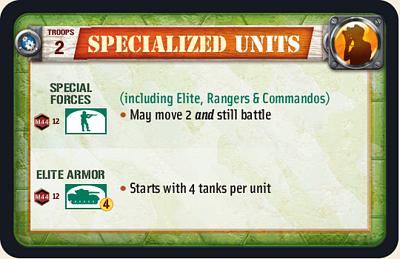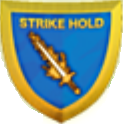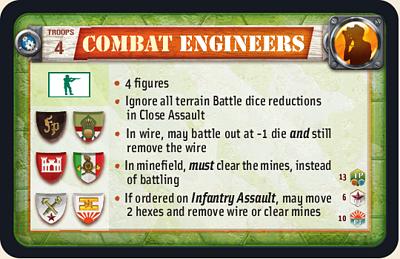Note: German Tiger Tanks do not currently have a badge to place on a standard armor figure to distinguish them from tanks that have been reduced to 1 figure. It's expected that you have the distinctive Tiger Tank model. On the scenario map they are represented by the elite armor symbol (tank with arch) and the number 1.
Elite Infantry Rules
Table of Contents

Note: Special Forces Infantry ordered by Infantry Assault still only move 2 and battle but may move 3 and not battle.
Elite National Badges
 |
US Rangers Dating all the way back to the 17th century, these elite units of the United States Army, played important roles in several of the battles of WWII - most notably the landing in Normandy, and in the Pacific theatre Merrill's Marauders made the Rangers famous. |
|
 |
US 101ST AIRBORNE DIVISION THE “SCREAMING EAGLES” The famous 101st Airborne Division was created in August 1942. They were the paratroopers who jumped on the night of D-Day on Normandy along with the 82nd Airborne Division. They participated in the Market Garden operation in September 1944, and were engaged in the Battle of the Bulge in December 1944, where they defended a critical road junction in Bastogne. The famous “Easy Company”, of the 506th Parachute Infantry Regiment, was part of the 101st Division. |
|
 |
MARINES This Marine badge (unlike other badges here) does not represent special forces. Instead it is used in scenarios with mixed forces to represent those units that get a command bonus order under Marine rules (Nations 4). A first-class Ambhibious Assault force, the United States Marine Corps grew from two brigades to six divisions and five air wings during World War II. A central force throughout the Pacific Theater, the Marines were in many of the most ferocious fights against the Imperial Japanese Army, forever identifying "The Corps" with the battlefields of Guadalcanal, Iwo Jima and Okinawa. Gung-Ho! - A declaration of enthusiasm originally used by the CommunistChinese 8th Route Army during World War II. Gung-Ho! was first introduced into the US Marine Corps by Franklin Delano Roosevelt's protégé, Major Evans F. Carlson, leader of the famed 2nd Marine Raider Battalion. Soon thereafter, the expression spread to become the rallying cry of all Marines throughout the Pacific Theater. |
|
 |
US 82ND AIRBORNE DIVISION |
|
 |
504TH PARACHUTE INFANTRY REGIMENT Sometimes known as the "White Devils", these soldiers form one of the most famous regiment of the 82nd Airborne Division. The 504th Parachute Infantry saw service in many of World War II's most famous battles, starting in North Africa and continuing onto Sicily, Italy, the Netherlands, and during the Battle of the Bulge, near Bastogne. |
|
 |
German Elite |
|
 |
GERMAN ROSETTE This mark is the German rosette mark, which was found on the wings of German aircraft and the sides of their tanks. |
|
 |
AFRIKA KORPS The Afrika Korps was created by the German High Command in February 1941 in Libya following the Italian defeat by the Allies in Operation Compass. Under the command of Erwin Rommel, it became a strong armored army, pushing the Allies back to their original position, with the exception of Tobruk. From 1941 to 1943, the Afrika Korps fought in many famous battles, including the Battle of the Kasserine Pass during the Tunisia campaign in February 1943. The remains of Afrika Korps and Italian troops surrendered to the Allied forces on May 13th, 1943. |
|
 |
BRANDENBURGERS 3-figure infantry unit. Has 1 enemy figure to masquerade as enemy, which provides extra defense until removed by special re-roll (see rules), or at unit's first battle. Then functions as Special Forces. |
|
 |
British Airborne |
|
 |
SAS: BRITISH SPECIAL AIR SERVICE Founded by British officer David Stirling during the British campaign in North-Africa, the SAS put small groups of highly-trained, specially-equipped commandos deep into enemy territory, using jeeps for maximum mobility. The SAS conducted devastating raids on German airfields and numerous other strategic targets. They went on to participate in many of the boldest and most daring operations of WWII. |
|
 |
BRITISH SPECIAL FORCES Apart from the famous SAS, there were many other Special Forces units in the British army. During the war years, Britain developed those highly trained units that would be put to good use in various theater of operations and write some of the most glorious pages of WWII history. |
|
 |
AUSTRALIA The Second Australian Imperial Force (2nd AIF) was originally formed in 1939 of volunteer units of the Australian Army. The various Divisions of the AIF were involved with distinction in theatres as different as North Africa against Germany, and New Guinea and Borneo against the Japanese Empire. The 9th Division distinguished itself at the Battle of Tobruk (1941) and El Alamein (1942). |
|
 |
NEW ZEALAND The main formation of New Zealand during WWII was the 2nd Division. After their loss in Greece and Crete, they joined the 8th British Army in North Africa. They played a key role in the victorious Second Battle of El Alamein against Rommel’s troops in November 1942. Later on, they participated in the Battle of Monte Cassino in Italy. |
|
 |
GURKHA Troops from the British Empire fought in every theatre during WWII. Gurkha soldiers from India fought in North Africa, the Middle East, Greece, Burma and Java. Four men of the 4th Division were awarded the Victoria Cross in Greece, and four others of the 5th Division also received the Victoria Cross in Java against the Japanese. |
|
 |
CHINDITS The Chindits were an international mix of British, Gurhkas, Burmese Rifles, Hong Kong volunteers and West African servicemen assembled to fight deep behind enemy lines. Variously known as the 77th Infantry Brigade and the 3rd Indian Infantry Division, the Chindits made their first expedition into the jungles of Japanese-occupied Burma during Operation Longcloth, in February 1943. |
|
 |
Elite Soviet Union |
|
 |
French This badge represents Elite French Army units in 1940 and Normandy Beach landings scenarios. Otherwise, it represents 3-figure French Resistance units, which have their own rules, and cannot move 2 and attack, normally. |
|
 |
2ÈME DIVISION BLINDÉE The story of the “2ème DB” is closely tied to the personality of its founder, French General Philippe de Hautecloque, best known as Général Leclerc. After retreating from a camp following the French defeat, General Leclerc joined Allied forces in North Africa to assemble the first elements of a new French army, which would officially become the 2nd Armored Division in 1943. Following numerous victories in North Africa, the 2ème DB landed in Normandy to participate in the campaign for the liberation of France. In August 1944, in a highly symbolic and political move, the 2ème DB entered Paris and freed it, before pushing east to Strasbourg, and then into Germany, all the way up to Berchtesgaden, Hitler’s private residence. |
|
 |
Japanese An elite group made of Japanese Navy and Army paratroopers, the "Giretsu" Special Forces were the Imperial Japanese Army's last-ditch answer to the B-29's air raids over the home islands. Trained for one-way travel to the USAAF bases on Guam, Saipan and the Ryukyu islands, the Giretsu made a name for themselves in a desperate night-drop over Okinawa, where they briefly seized control of the Yontan and Kadena air strips, and in similar operations over Iwo Jima, Guam and Saipan. |
|
 |
Italian This Italian badge (unlike other badges here) does not represent special forces. Instead it shows units in mixed forces that benefit from Italian Army Rules regarding flag rolls and retreats. |
|
 |
ELITE ITALIAN ASSAULT DIVISION “DIVISIONE LITTORIO D’ASSALTO” Formed in November 1939, it was composed of the 33rd tank regiment, the 12th Bersaglieri regiment and the 133rd artillery “Littorio” regiment. First committed to combat in the Alps, then in the Balkans, it moved to North Africa in 1941, where it replaced the 33rd Armored with the 133rd Armored. The unit fought at El Alamein, where it was almost entirely wiped out, and dissolved in November 1942. |
|
| Minor Nations: |
||
 |
POLISH TROOPS After the defeat in 1939, the Polish government in exile in France organized a new army. This army took part in the defense of France both on the ground and in the air. Following the fall of France, many Polish troops were evacuated to Britain. During the Battle of Britain, the Polish 303 Fighter Squadron achieved the highest number of victories of all Allied squadrons. Polish troops were also involved in many famous battles, like the battle of Arnhem during Operation Market Garden, and the fourth battle for Monte Cassino. |
|
 |
POLISH DRAGOONS |
|
 |
YUGOSLAV PARTISANS The Yugoslav partisans resisted against the occupation of their country by Axis forces during WWII. Their main organization was the People’s Liberation Army and Partisan detachments of Yugoslavia, under the command of Yugoslav Communist Party leader Josip Broz, famously known as “Tito”. The partisans fought a guerrilla war and applied communist organization in areas under their control. |
|
 |
SPANISH REPUBLICANS From 1936 to 1939, Spain experienced a bitter civil war between the Spanish Republicans and the Nationalist rebellion led by General Franco. Franco succeeded in overthrowing the Republican government and establishing a dictatorship. Among Republicans were many communist and anarchist groups, like the CNT (Anarcho-Syndicalist Trade Unions). Small contingents of volunteers from many different countries participated in the civil war, including American and British volunteers on the Republican side, and pro-Nazi military forces on the Nationalist side. |
|
 |
CHINESE NATIONALIST FORCES When WWII broke out, China was already in the midst of a violent conflict that began in 1927 between the Nationalist forces of Chiang Kai-shek and the Communist forces of Mao Zedong. The Japanese took advantage of this conflict to invade and occupy large parts of China. Chiang Kai-shek and Mao Zedong made a truce to fight their common enemy, with some support from the Allies. Following WWII, Mao’s Communist Party would fight to victory in 1949, and found the People’s Republic in China. Chiang Kai-shek and over 2 millions refugees fled to the island of Taiwan and founded the Republic of China. |
|
Engineers Rules
Combat Engineer units were used throughout WWII to increase the combat effectiveness of the Corps. They provided mobility, counter−mobility, survivability, topographic and engineering support.An Engineer unit moves and battles like a Standard unit.
Most rules are on the following reference card:

- In Close Assault Combat, an Engineer unit ignores all terrain Battle Dice reductions, i.e. their enemies are not protected by their terrain.
- An Engineer unit that is on a hex with wire will reduce the number of Battle Dice it rolls by 1 and may also remove the wire from the hex after the battle.
- An Engineer unit that moves onto a Minefield hex and that is eligible to battle must clear the Minefield hex instead of battling. If the Engineer unit cannot clear the Minefield, it detonates.
- An Engineer ordered by Infantry Assault, may move 2 hexes then remove wire or clear mines.
- An Engineer may clear a Roadblock obstacle instead of battling.
Engineers Badges
 |
GERMAN ENGINEERS The “Fp” arm badge shown here was for fortification construction engineers. |
 |
ITALIAN ENGINEERS The history of Italian Engineers dates as far back as the early 16th century. With the introduction of gunpowder and cannon, a new design had to be found for fortresses so that they would better resist these advances in warfare technology. The result was the “trace italienne”: star-shaped fortresses surrounding towns and even cities with outlying defenses. In the 1530s and 1540s, this new design spread from Italy throughout Europe, and Italian Engineers were in high demand. The concepts were refined over the centuries, and were still used durind the 1914-1418 Great War. |
 |
ROYAL ENGINEERS Royal Engineers have played an important role in all of the conflicts where Great Britain participated. For this reason, King William IV awarded them their ‘ubique’ motto in 1832, to explain that they had taken part in every battle fought by the British Army. During WWII, the Royal Engineers skills were extensively used for bomb disposal, mine detection, bridge building, etc. |
 |
US ENGINEERS The turreted castle is the symbol of the US Army Corps of Engineers. In heraldry, this symbol was used to describe men who overcame walled fortifications. The US Army started using this symbol in 1840. It was then used on various clothing elements such as epaulets, belt plates, caps, shoulder knots, buttons, etc. Even though the general shape would evolve, it has remained the distinctive symbol of the Corps of Engineers. |
 |
SOVIET ENGINEERS Combat Engineer units were used throughout WWII to increase the combat effectiveness of the Corps. They provided mobility, counter−mobility, survivability, topographic and engineering support. |
 |
JAPANESE ENGINEERS |
Specialty Badges
 |
ANTI-TANK -SWA Infantry unit that cannot Take Ground, but has improved attack vs armor. The development of man-portable, anti-tank weapons took off during World War II. Their High Explosive Anti-Tank (HEAT) shells were soon found to penetrate armor better than some of the larger, much less mobile, anti-tank guns, at a fraction of the weight. |
 |
BIG GUN Artillery unit with increased range and attack. |
 |
CAVALRY Infantry unit with increased move and modified attack, but reduced range. |
 |
COMMAND CARS 1-figure infantry that cannot battle, but modifies Command Card procedures and has increased defense |
 |
DEPLETED UNITS This unit does not have the normal figures for the unit, it cannot be increased past its starting number, and does not count as a victory point when destroyed or exited. |
 |
FLAME-THROWER TANKS Armor unit with increased attack. |
 |
HALF-TRACKS Armor unit with limited move and reduced attack that can sometimes resupply a wounded unit with its figures. |
 |
HEAVY ANTI-TANK GUN (88s) Artillery unit limited to line-of-sight attacks and reduced but modified attack. |
 |
HOBART'S FUNNIES Armor unit with special ability based on type chosen at start of scenario. |
 |
JUNGLE FIGHTERS Infantry unit that ignores movement restrictions and defense of jungles. |
 |
LONG-RANGE PATROL CARS 1-figure infantry unit with increased movement and increased defense. |
 |
MACHINE GUNS -SWAs Infantry unit that cannot Take Ground, but has improved attack vs infantry. |
 |
MOBILE ARTILLERY Artillery unit with increased movement and move and battle option (except with Artillery Bombard). |
 |
MORTARS -SWAs Infantry unit that cannot Take Ground, but has improved attack. Late War version has increased range. |
 |
SCREAMING MEEMIES Artillery unit with battle options, but reduced defense. |
 |
SKI TROOPS 3-figure infantry unit with increased and modified movement, enhanced retreat, but reduced range. |
 |
SNIPER - GERMAN 1-figure unit with increased range and defense, modified attack, but does not count as a victory point when destroyed or exited. |
 |
SNIPER - SOVIET Same as above. |
 |
SUPPLY TRUCKS Infantry unit that cannot battle, but can resupply wounded units with its figures. |
 |
TANK DESTROYERS Armor unit with increased range, reduced but modified attack, less defense, and enhanced retreat. |